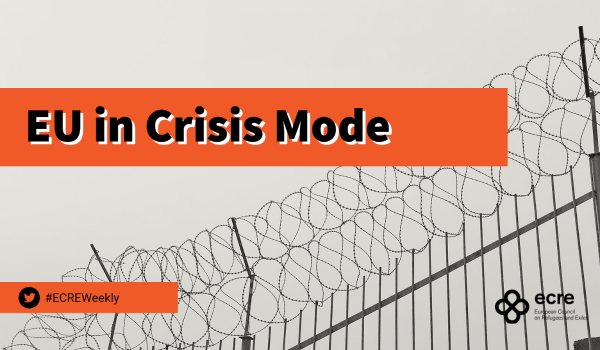The European Border and Coast Guard Agency (Frontex) reports a 12 per cent decrease in arrivals in January compared to the same month in 2022, with Afghans and Syrians the two main nationalities of arrivals. Meanwhile, the conclusions of the Special Council Summit repeat crisis narrative and corresponding ‘solutions’ of prevention and return. Germany latest country to explore external processing after 20 years of continued failures.
According to Frontex: “In January, more than 13 200 irregular border crossings were detected at EU’s external borders, down 12% from a year ago in large part due to poor weather conditions on some sea routes” – Syrians and Afghans remain top countries of origin. While Frontex has stated 2022 saw some “330 000 irregular border crossings at EU’s external border, the highest number since 2016” those statistics refer to the number of crossings. As outlined by ECRE: “Frontex figures refer to border crossings not the number of people arriving irregularly. As some people have to cross more than one EU border the number of people is quite a bit lower than the headline figure”. Further, in its review of asylum statistics for 2022, ECRE has pointed to the problematic use of statistics by EU and member state officials, with the claim often made that more than half the people arriving have no protection needs: “Despite the constant misrepresentations, the protection rate for people seeking sanctuary in Europe remains high, with 40% receiving refugee status or subsidiary protection at first instance, and a further 10% or so being granted protection statuses under national law”. It further notes that, at appeal stage, even more people are found to be entitled protection.
Nonetheless, member state reactions in the run up to the Special European Council summit on 9 February, as well as its conclusions reflect the return to a crisis narrative. On 6 February, an alliance of countries consisting of Denmark, Lithuania, Greece, Latvia, Slovakia, Malta, Estonia and Austria – most of which had very modest numbers of asylum applications in 2022 – issued a letter to the European Commission. The letter defines the European asylum system as a pull factor given a “very low rate of returns” and claims. without reference to sources or calculation methods, that: “Today, more than half of asylum applications filed in the EU, and in some Member States more than 80 percent of the asylum applications, are deemed unfounded and are thus rejected”. Based on those assertions, the alliance urges further strengthening the protection of external borders, significantly increasing swift returns of third country nationals without the right to legal stay in the EU, developing new partnerships and safe third country arrangements, and ensuring the alignment with the EU of certain third countries’ own visa policies. The recommendations of the unusual alliance as well as similar ones from other member states and the doubtful reasoning behind them, were adopted almost verbatim in the Conclusions of the Summit (Part III Migration). With the starting point being the alleged crisis, the document summarizes: “The European Union will step up its action to prevent irregular departures and loss of life, to reduce pressure on EU borders and on reception capacities, to fight against smugglers and to increase returns. This will be done by intensifying cooperation with countries of origin and transit through mutually beneficial partnerships. All migratory routes should be covered, also with adequate resources”. ECRE responded: “Up all night to cook up same old recipe: (Mis)use external action and funding to pressure other countries to prevent people arriving. (Mis)use “diplomacy, development, trade and visas” to increase returns. Use all means possible – all the expensive tech arms companies can produce – to deny access at borders. Commission “helpfully” contextualises discussion by referring to “illegal” border crossings and misrepresenting the protection rate – again”. ECRE further noted: “Funding for the 14,647km Great Wall of Europe NOT agreed” and warned of four issues to watch, including: “Expansion of Frontex external adventures, “Instrumentalisation” focus with wider scope including “transport operators”??, pressure on other countries to change THEIR visa regimes and JHA Council looking at “operations of private entities” at borders – NGO SAR operations”.
Meanwhile, Germany is revisiting the old idea of externalizing asylum procedures to countries outside the EU. In a response to the EU Observer, ECRE Director, Catherine Wooollard stated: “Proposals for external processing of asylum applications re-emerge regularly. But it never happens because the legal, political and practical obstacles are extensive. Above all, other countries have no interest in hosting asylum processing centres for Europe, despite pressure, threats and bribes. The first major discussions on the topic at EU-level took place 20 years ago and still nothing has happened because the ideas are unworkable. Currently, it is the turn of Germany to assess the (lack of) options for external processing because it was pushed into the coalition agreement during the formation of the current government. It won’t lead to anything. In Denmark and the UK, plans are stalled, having cost money and produced zero results. Rather than wasting resources on vague and unrealistic proposals for external processing which never work, Germany would be better off supporting efforts to make asylum function in Europe. As well as improving its own asylum system, Germany has a strong direct interest in ensuring better implementation of EU asylum law across Europe as a whole, and by all countries”.
For further information:
- ECRE, EU Concerned About Increase in People Seeking Protection, February 2023
- ECRE Editorial: Calm Down, Mate: Asylum in 2022, February 2023
This article appeared in the ECRE Weekly Bulletin. You can subscribe to the Weekly Bulletin here.

